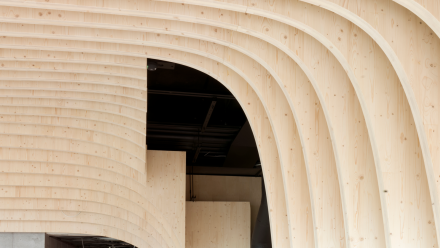Facts
Location
United Kingdom
Nemetschek Group Brands
Vectorworks
Client
A&Q Partnership
Technology used
Vectorworks Architect
Nick Lawrence didn’t get his start in architecture. Now a Practice director who leads the BIM strategy at A&Q Partnership, originally, Lawrence actually pursued engineering in his undergraduate studies, the knowledge from which he finds helpful to his application of architectural design.
Whereas engineering can be viewed as purely technical with an emphasis on applied mathematics, architecture is a practice that’s more heavily focused on design and aesthetics — a visual art that can be interpreted by both consultants and clients. For Lawrence, these two seemingly disparate mindsets intersect with building information modeling, or BIM, which merges his technical background with architecture’s more visual nature.
“I’ve enjoyed producing technical drawings, and I think technical drawings can be useful pieces of art in their own way,” Lawrence explained of his career path, which turned towards architecture over 20 years ago. “I was looking around at getting into product design and moving away from the mathematical purity of mechanical engineering.”
Working as a technician for an architect at A&Q Partnership, Lawrence was able to pursue a degree in architecture, then capitalize on relationships he built as a technician for A&Q Partnership to pursue an architecture career.
“Basically, someone took me out for lunch, sat me down, and suggested architecture was a good idea,” he said. “And looking back, I can’t really imagine what else I’d be doing at the moment. I like the artistic side of architecture, but then I also like solving technical details in construction work. It’s one of the few jobs I can think of where you can do that, you know?”
His first job with A&Q Partnership was in 1998, and after a few years running his own practice with his wife, Lawrence returned to A&Q Partnership as a director, where he’s been expounding the merits of BIM for over seven years.
Nick Lawrence, Director
“It’s pretty evident that BIM is the next evolution in software. There’s an inherent logic in having a 3D model and producing information from it. It feels efficient and sensible.”
A&Q Partnership’s Pathway to BIM
A&Q Partnership use BIM workflows on all projects, and their journey to reaching that level is in part due to Lawrence, who has been interested in BIM since before the UK government’s 2016 mandate for BIM on all publicly funded projects.
“I’ve always been quite interested in keeping up with what’s happening on a technical front,” Lawrence said. “Most of our clients are private developers so there’s no statutory requirement for us to conform to the mandate. But still, prior to 2016, BIM was on my radar as something we should be competent at, because we didn’t want to miss any jobs or contracts because of an inability there.”
This sentiment is echoed by many architects who want to avoid falling behind in the industry. Even though BIM isn’t a requirement in many areas yet, there already exists a certain pressure in the industry to incorporate smart 3D modeling and non-proprietary data management.
“It’s pretty evident that BIM is the next evolution in software,” Lawrence said. “There’s an inherent logic in having a 3D model and producing information from it. It feels efficient and sensible.”
With a keen sensitivity to detail, Lawrence plays a major role in training staff to office standards, particularly to their resource management system which keeps projects organized and consistent. The consistency with which A&Q Partnership applies BIM workflows to their projects means they were well prepared for a recent job, a massive 1200-unit residential project for Berkeley Homes, one of the largest housing developers in Europe.
The Eight Gardens at Watford
With claims of the project “Manhattanizing” Watford, which is just outside of London, the Eight Gardens development aims to deliver over 1,200 new homes to the area. Alongside future plans for a primary school and community amenities like a dentist’s office, the Eight Gardens development is part of a much larger modernization of the area, according to the Watford Borough Council.
Currently at Stage 3 of the RIBA’s Plan of Work, the Eight Gardens scheme sits close to Watford Junction, a large train station through which passengers can reach Central London in just 20 minutes. Lawrence said the location itself is a good development opportunity comprising two distinct phases, though as of the writing of this article A&Q Partnership is mainly working on the first phase, which solely concerns the Eight Gardens south of the Penn Road.
Open BIM: Collaboration with Consultants
Among the landscaped elements in the Eight Gardens project are amenity spaces and shared gardens exclusively accessed by the private residents on top of the shoulder blocks, as well as blue and green roofs on top of the towers. There are also large, publicly accessed landscaped steps and squares and streets throughout the site at ground level.
With the various consultants on the project at various levels of experience with BIM, some not as familiar with BIM workflows as A&Q Partnership, the initial appointments did not formally stipulate a BIM workflow. However, the teams were keen on developing the way they work, and so agreed to proceed as a BIM project even though it wasn’t obligatory.
“We offered that we’d develop it as a BIM job despite it not being contractually required, partly to help others in the learning process in adopting,” Lawrence said, explaining how this left them in a “slightly strange position” at the beginning of the project, charting unfamiliar territory with some parties. The team got together and set expectations for each other, then followed through with a tight execution plan. A&Q Partnership worked with the .dwg files and .ifc files by referencing them into Vectorworks.








